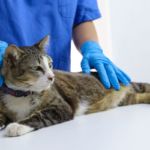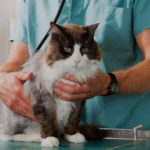Maintaining a healthy coat and skin is essential for your cat’s overall well-being. Regular grooming not only keeps your feline friend looking their best but also promotes their health by preventing matting, reducing shedding, and addressing skin issues. Here’s a comprehensive guide to essential grooming tips that will help keep your cat’s coat and skin in top condition.

1. Understand Your Cat’s Coat Type
1. Short-Haired Cats:
- Regular Brushing: Short-haired cats typically require less grooming, but regular brushing helps reduce shedding and minimizes hairballs. A weekly brushing session with a soft-bristled brush or grooming glove is usually sufficient.
- Skin Health: Even short-haired cats can benefit from occasional skin checks to ensure there are no signs of irritation, parasites, or abnormal lumps.
2. Long-Haired Cats:
- Daily Brushing: Long-haired cats need more frequent grooming to prevent their hair from becoming tangled and matted. Daily brushing with a wide-toothed comb or a slicker brush helps manage tangles and keeps the coat smooth.
- Mat Removal: Address mats and tangles promptly to avoid discomfort and skin irritation. Use a mat splitter or seek professional grooming help if mats are severe.
2. Brushing and Combing
1. Benefits of Regular Brushing:
- Reduces Shedding: Regular brushing removes loose hairs and dander, helping to reduce shedding and minimize hairballs.
- Prevents Matting: Brushing helps prevent tangles and mats, which can be uncomfortable and lead to skin issues.
- Promotes Circulation: Brushing stimulates blood flow to the skin, which supports healthy hair growth.
2. Choosing the Right Tools:
- Bristle Brushes: Ideal for short-haired cats, bristle brushes help remove loose hair and dirt.
- Slicker Brushes: Great for long-haired cats, slicker brushes can penetrate the coat to remove tangles and mats.
- Combs: Metal combs with varying tooth widths are useful for detangling and checking for parasites.
3. Bathing Your Cat
1. Frequency:
- Minimal Baths: Most cats do not need regular baths and often groom themselves effectively. Bathing should be done only when necessary, such as when your cat is particularly dirty or has skin conditions that require medicated baths.
- Use Cat-Specific Products: Always use shampoos and conditioners formulated specifically for cats, as human products can be too harsh for their skin.
2. Bathing Tips:
- Prepare Ahead: Gather all necessary supplies before starting, including cat shampoo, towels, and a detachable shower head or pitcher.
- Stay Calm: Use a calm and reassuring voice to keep your cat relaxed. If possible, have someone assist you to hold the cat or keep them calm during the process.
- Thorough Rinsing: Ensure all shampoo is thoroughly rinsed out to prevent skin irritation. Dry your cat gently with a towel and provide a warm, comfortable place to rest afterward.
4. Nail Trimming
1. Importance of Nail Care:
- Prevents Overgrowth: Regular nail trimming prevents nails from becoming too long, which can cause discomfort and potential injury.
- Avoids Scratching: Keeping nails trimmed helps reduce the likelihood of accidental scratches.
2. How to Trim:

- Use Cat Nail Clippers: Invest in clippers designed for cats, such as scissor-style or guillotine-style clippers.
- Cut Carefully: Trim only the sharp tip of the nail to avoid hitting the quick (the pink area that contains nerves and blood vessels). If your cat has dark nails, trim a small amount at a time and check for any changes in color.
5. Skin Health Checks
1. Regular Inspections:
- Check for Parasites: During grooming, inspect your cat’s skin for signs of fleas, ticks, or mites. Look for scratching, redness, or small black specks (flea dirt).
- Monitor for Abnormalities: Keep an eye out for lumps, bumps, or areas of redness. If you notice any unusual changes, consult your vet for further evaluation.
2. Addressing Skin Issues:
- Allergies: If your cat shows signs of skin irritation or itching, they may have allergies. Discuss potential allergens with your vet and consider hypoallergenic diets or products.
- Moisturizing: For cats with dry skin, consider using a moisturizing spray or adding omega-3 fatty acids to their diet to improve skin hydration.
6. Dental Care
1. Importance:
- Prevents Oral Health Issues: Regular dental care helps prevent dental diseases, bad breath, and tartar buildup.
2. Brushing:
- Use Cat Toothpaste: Brush your cat’s teeth with toothpaste formulated for cats. Aim for a few times a week to maintain oral health.
Conclusion
Regular grooming is crucial for maintaining your cat’s coat and skin health. By understanding your cat’s specific grooming needs, using the right tools, and addressing any health concerns promptly, you can ensure your feline friend remains comfortable and well-cared-for. Regular brushing, occasional baths, nail trimming, and skin checks contribute to a happy, healthy cat with a beautiful, well-maintained coat. Incorporate these grooming practices into your routine to enhance your cat’s overall well-being and strengthen your bond with your furry companion.


